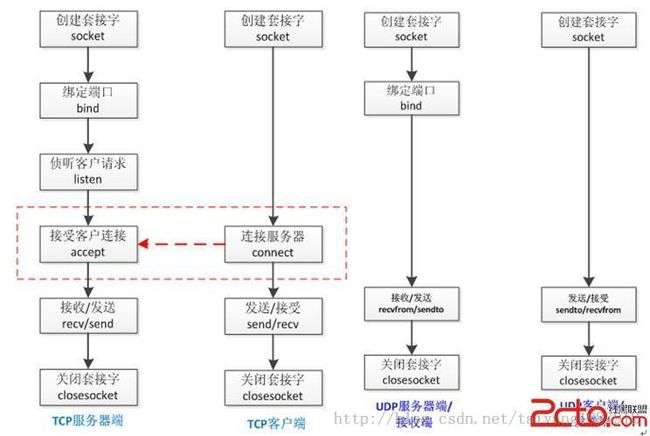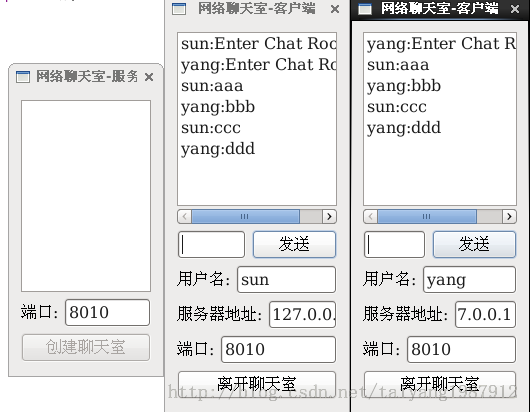Qt浅谈之十六:TCP和UDP(之一)
一、简介
Qt使用QtNetwork模块来进行网络编程,提供了一层统一的套接字抽象用于编写不同层次的网络程序,避免了应用套接字进行网络编的繁琐(因有时需引用底层操作系统的相关数据结构)。有较底层次的类如QTcpSocket、QTcpServer和QUdpSocket等来表示低层的网络概念;还有高层次的类如QNetworkRequest、QNetworkReply和QNetworkAccessManager使用相同的协议来执行网络操作;也提供了QNetworkConfiguration、QNetworkConfigurationManager和QNetworkSession等类来实现负载管理。
二、分析图
(1)网络通讯协议
(2)TCP和UDP客户端和服务器的创建流程
三、TCP
TCP是一种可靠的、面向连接、面向数据流的传输协议,多数高层网络协议都使用TCP协议,包括HTTP和FTP,TCP协议非常适合数据的连续传输。QTcpSocket类为TCP提供了一个接口,继承自QAbstractSocket。TCP编程一般分为客户端和服务器端,即C/S(Client/Server)模型。
1、运行图
服务器监听8010端口,客户端连接。服务器端接收到连接及其信息的同时将信息发送给所有的客户端,客户端显示获得的信息。
2、代码
(1)TCP服务器端(完整代码在csdn上)
#include "tcpserver.h"
#include <QApplication>
int main( int argc, char **argv )
{
QApplication a( argc, argv );
QTranslator translator(0);
translator.load("tcpserver_zh",".");
a.installTranslator(&translator);
TcpServer *tcpserver = new TcpServer();
tcpserver->show();
return a.exec();
}
#include "tcpserver.h"
TcpServer::TcpServer( QWidget *parent, Qt::WindowFlags f )
: QDialog( parent, f )
{
QFont font("ZYSong18030",12);
setFont(font);
setWindowTitle(tr("TCP Server"));
QVBoxLayout *vbMain = new QVBoxLayout( this );
ListWidgetContent = new QListWidget( this);
vbMain->addWidget( ListWidgetContent );
QHBoxLayout *hb = new QHBoxLayout( );
LabelPort = new QLabel( this );
LabelPort->setText(tr("Port:"));
hb->addWidget( LabelPort );
LineEditPort = new QLineEdit(this);
hb->addWidget( LineEditPort );
vbMain->addLayout(hb);
PushButtonCreate = new QPushButton( this);
PushButtonCreate->setText( tr( "Create" ) );
vbMain->addWidget( PushButtonCreate );
connect(PushButtonCreate,SIGNAL(clicked()),this,SLOT(slotCreateServer()));
port = 8010;
LineEditPort->setText(QString::number(port));
}
TcpServer::~TcpServer()
{
}
void TcpServer::slotCreateServer()
{
server = new Server(this,port);
connect(server,SIGNAL(updateServer(QString,int)),this,SLOT(updateServer(QString,int)));
PushButtonCreate->setEnabled(false);
}
void TcpServer::updateServer(QString msg,int length)
{
ListWidgetContent->addItem (msg.left(length) );
}
#include <QtNetwork>
#include "server.h"
Server::Server(QObject *parent,int port)
: QTcpServer(parent)
{
listen(QHostAddress::Any,port);
}
void Server::incomingConnection(int socketDescriptor)
{
TcpClientSocket *tcpClientSocket = new TcpClientSocket(this);
connect(tcpClientSocket,SIGNAL(updateClients(QString,int)),this,SLOT(updateClients(QString,int)));
connect(tcpClientSocket,SIGNAL(disconnected(int)),this,SLOT(slotDisconnected(int)));
tcpClientSocket->setSocketDescriptor(socketDescriptor);
tcpClientSocketList.append(tcpClientSocket);
}
void Server::updateClients(QString msg,int length)
{
emit updateServer(msg,length);
for(int i=0;i<tcpClientSocketList.count();i++)
{
QTcpSocket *item=tcpClientSocketList.at(i);
if(item->write(msg.toLatin1(), length)!=length)
{
continue ;
}
}
}
void Server::slotDisconnected(int descriptor)
{
for(int i=0;i<tcpClientSocketList.count();i++)
{
QTcpSocket *item=tcpClientSocketList.at(i);
if(item->socketDescriptor ()==descriptor)
{
tcpClientSocketList.removeAt(i);
return;
}
}
return;
}
#include "tcpserver.h"
TcpClientSocket::TcpClientSocket( QObject *parent)
{
connect(this, SIGNAL(readyRead()),this, SLOT(dataReceived()));
connect(this, SIGNAL(disconnected()),this, SLOT(slotDisconnected()));
}
TcpClientSocket::~TcpClientSocket()
{
}
void TcpClientSocket::dataReceived()
{
while (bytesAvailable()>0)
{
char buf[1024];
int length=bytesAvailable();
read(buf, length);
QString msg=buf;
emit updateClients(msg,length);
}
}
void TcpClientSocket::slotDisconnected()
{
emit disconnected(this->socketDescriptor ());
}
(2)TCP客户端
#include "tcpclient.h"
TcpClient::TcpClient( QWidget *parent, Qt::WindowFlags f )
: QDialog( parent, f )
{
QFont font("ZYSong18030",12, QFont::Normal);
setFont(font);
setWindowTitle(tr("TCP Client"));
QVBoxLayout *vbMain = new QVBoxLayout( this );
ListWidgetContent = new QListWidget( this);
vbMain->addWidget( ListWidgetContent );
QHBoxLayout *hb1 = new QHBoxLayout( );
LineEditSend = new QLineEdit(this);
hb1->addWidget( LineEditSend );
PushButtonSend = new QPushButton( this);
PushButtonSend->setText( tr( "Send" ) );
hb1->addWidget( PushButtonSend );
vbMain->addLayout( hb1 );
QHBoxLayout *hb2 = new QHBoxLayout( );
LabelUser = new QLabel( this );
LabelUser->setText(tr("User Name:"));
hb2->addWidget( LabelUser );
LineEditUser = new QLineEdit(this);
hb2->addWidget( LineEditUser );
QHBoxLayout *hb3 = new QHBoxLayout( );
LabelServerIP = new QLabel( this );
LabelServerIP->setText(tr("Server:"));
hb3->addWidget( LabelServerIP );
LineEditServerIP = new QLineEdit(this);
hb3->addWidget( LineEditServerIP );
QHBoxLayout *hb4 = new QHBoxLayout( );
LabelPort = new QLabel( this );
LabelPort->setText(tr("Port:"));
hb4->addWidget( LabelPort );
LineEditPort = new QLineEdit(this);
hb4->addWidget( LineEditPort );
vbMain->addLayout(hb2);
vbMain->addLayout(hb3);
vbMain->addLayout(hb4);
PushButtonEnter = new QPushButton( this);
PushButtonEnter->setText( tr( "Enter" ) );
vbMain->addWidget( PushButtonEnter );
connect(PushButtonEnter,SIGNAL(clicked()),this,SLOT(slotEnter()));
connect(PushButtonSend,SIGNAL(clicked()),this,SLOT(slotSend()));
serverIP = new QHostAddress();
port = 8010;
LineEditPort->setText(QString::number(port));
status=false;
PushButtonSend->setEnabled( false );
}
TcpClient::~TcpClient()
{
}
void TcpClient::slotEnter()
{
if(!status)
{
QString ip=LineEditServerIP->text();
if(!serverIP->setAddress(ip))
{
QMessageBox::information(this,tr("error"),tr("server ip address error!"));
return;
}
if(LineEditUser->text()=="")
{
QMessageBox::information(this,tr("error"),tr("User name error!"));
return ;
}
userName=LineEditUser->text();
tcpSocket = new QTcpSocket(this);
connect(tcpSocket,SIGNAL(connected()),this,SLOT(slotConnected()));
connect(tcpSocket,SIGNAL(disconnected()),this,SLOT(slotDisconnected()));
connect(tcpSocket, SIGNAL(readyRead()),this, SLOT(dataReceived()));
tcpSocket->connectToHost ( *serverIP, port);
status=true;
}
else
{
int length = 0;
QString msg=userName+tr(":Leave Chat Room");
if((length=tcpSocket->write(msg.toLatin1(),msg.length()))!=msg.length())
{
return ;
}
tcpSocket->disconnectFromHost();
status=false;
}
}
void TcpClient::slotConnected()
{
int length = 0;
PushButtonSend->setEnabled( true );
PushButtonEnter->setText(tr("Leave"));
QString msg=userName+tr(":Enter Chat Room");
if((length=tcpSocket->write(msg.toLatin1(),msg.length()))!=msg.length())
{
return ;
}
}
void TcpClient::slotDisconnected()
{
PushButtonSend->setEnabled( false );
PushButtonEnter->setText(tr("Enter"));
}
void TcpClient::slotSend()
{
if(LineEditSend->text()=="")
{
return ;
}
QString msg=userName+":"+LineEditSend->text();
tcpSocket->write(msg.toLatin1(),msg.length());
LineEditSend->clear();
}
void TcpClient::dataReceived()
{
while (tcpSocket->bytesAvailable()>0)
{
QByteArray datagram;
datagram.resize(tcpSocket->bytesAvailable());
QHostAddress sender;
tcpSocket->read(datagram.data(), datagram.size());
QString msg=datagram.data();
ListWidgetContent->addItem (msg.left(datagram.size()));
}
}
3、其他TCP服务器和客户端代码
(1)TCP服务器——基本模式
#ifndef SERVER_H
#define SERVER_H
#include <QObject>
#include <QTcpServer>
class server : public QObject
{
Q_OBJECT
public:
explicit server(QObject *parent = 0);
private:
QTcpServer *tcpServer;
QTcpSocket *clientConnection;
signals:
public slots:
void sendMessage();
void on_Ready_Read();
};
#endif // SERVER_H
#include <QTcpSocket>
#include "server.h"
server::server(QObject *parent) :
QObject(parent)
{
tcpServer = new QTcpServer(this);
// 使用了IPv4的本地主机地址,等价于QHostAddress("127.0.0.1")
if (!tcpServer->listen(QHostAddress::Any, 59769)) {
qDebug() << tcpServer->errorString();
}
connect(tcpServer, SIGNAL(newConnection()), this, SLOT(sendMessage()));
}
void server::sendMessage()
{
clientConnection = tcpServer->nextPendingConnection();
clientConnection->write("hello client\r\n");
clientConnection->flush();
clientConnection->waitForBytesWritten(3000);
connect(clientConnection, SIGNAL(readyRead()), this, SLOT(on_Ready_Read()));
connect(clientConnection, SIGNAL(disconnected()), clientConnection, SLOT(deleteLater()));
}
void server::on_Ready_Read()
{
QByteArray block = clientConnection->readAll();
qDebug() << "server = " << block;
QString commandXml = QString("<event>" " <object>USER</object>" " <action>LOGINSUCCESS</action>" " <data>" " </data>" "</event>");
QByteArray data = commandXml.toUtf8();
QString str = QString("%1:%2,").arg(data.size()).arg(QString::fromUtf8(data));
clientConnection->write(str.toUtf8()); clientConnection->disconnectFromHost();
}
(2)TCP服务器——线程处理
#ifndef MYSERVER_H
#define MYSERVER_H
#include <QTcpServer>
#include <QDebug>
#include "mythread.h"
class MyServer : public QTcpServer
{
Q_OBJECT
public:
explicit MyServer(QObject *parent = 0);
void StartServer();
protected:
void incomingConnection(int socketDescriptor);
signals:
public slots:
};
#endif // MYSERVER_H
#ifndef MYTHREAD_H
#define MYTHREAD_H
#include <QThread>
#include <QTcpSocket>
#include <QDebug>
class MyThread : public QThread
{
Q_OBJECT
public:
explicit MyThread(int ID, QObject *parent = 0);
void run();
signals:
void error(QTcpSocket::SocketError socketerror);
public slots:
void readyRead();
void disconnected();
private:
QTcpSocket *socket;
int socketDescriptor;
};
#endif // MYTHREAD_H
#include <QCoreApplication>
#include "myserver.h"
int main(int argc, char *argv[])
{
QCoreApplication a(argc, argv);
MyServer server;
server.StartServer();
return a.exec();
}
#include "myserver.h"
MyServer::MyServer(QObject *parent) :
QTcpServer(parent)
{
}
void MyServer::StartServer()
{
if (!listen(QHostAddress::Any, 1234)) {
qDebug() << "Could not start server";
}
else {
qDebug() << "Listening...";
}
}
void MyServer::incomingConnection(int socketDescriptor)
{
qDebug() << socketDescriptor << ":connecting...";
MyThread *thread = new MyThread(socketDescriptor, this);
connect(thread, SIGNAL(finished()), this, SLOT(deleteLater()));
thread->start();
}
#include "mythread.h"
MyThread::MyThread(int ID, QObject *parent) :
QThread(parent)
{
socketDescriptor = ID;
}
void MyThread::run()
{
//thread starts here
qDebug() << socketDescriptor << ":starting thread";
socket = new QTcpSocket;
if (!socket->setSocketDescriptor(socketDescriptor)) {
emit error(socket->error());
return;
}
connect(socket, SIGNAL(readyRead()), this, SLOT(readyRead()), Qt::DirectConnection);
connect(socket, SIGNAL(disconnected()), this, SLOT(disconnected()), Qt::DirectConnection);
qDebug() << socketDescriptor << ":client connected!";
exec();
}
void MyThread::readyRead()
{
QByteArray Data = socket->readAll();
qDebug() << socketDescriptor << ":Data in:" << Data;
socket->write(Data);
}
void MyThread::disconnected()
{
qDebug() << socketDescriptor << ":Disconnected!";
socket->deleteLater();
exit(0);
}
(3)TCP服务器——线程池
#ifndef MYSERVER_H
#define MYSERVER_H
#include <QTcpServer>
#include <QThreadPool>
#include <QDebug>
#include "myrunnable.h"
class MyServer : public QTcpServer
{
Q_OBJECT
public:
explicit MyServer(QObject *parent = 0);
void StartServer();
protected:
void incomingConnection(int handle);
private:
QThreadPool *pool;
signals:
public slots:
};
#endif // MYSERVER_H
#ifndef MYRUNNABLE_H
#define MYRUNNABLE_H
#include <QRunnable>
#include <QTcpSocket>
#include <QDebug>
class MyRunnable : public QRunnable
{
public:
MyRunnable();
int SocketDescriptor;
protected:
void run();
};
#endif // MYRUNNABLE_H
#include "myserver.h"
MyServer::MyServer(QObject *parent) :
QTcpServer(parent)
{
pool = new QThreadPool(this);
pool->setMaxThreadCount(5);
}
void MyServer::StartServer()
{
if (listen(QHostAddress::Any, 1234)) {
qDebug() << "Server started!";
}
else {
qDebug() << "Server did not start!";
}
}
void MyServer::incomingConnection(int handle)
{
MyRunnable *task = new MyRunnable();
task->setAutoDelete(true);
task->SocketDescriptor = handle;
pool->start(task);
}
#include "myrunnable.h"
MyRunnable::MyRunnable()
{
}
void MyRunnable::run()
{
if (!SocketDescriptor) return;
QTcpSocket socket;
socket.setSocketDescriptor(SocketDescriptor);
socket.write("hello world\r\n");
socket.flush();
socket.waitForBytesWritten();
socket.close();
}
#include <QCoreApplication>
#include "myserver.h"
int main(int argc, char *argv[])
{
QCoreApplication a(argc, argv);
MyServer Server;
Server.StartServer();
return a.exec();
}
(4)TCP服务器——高级异步方式并使用线程池
尽可能理解这种方式,效率相对比较客观。运行结果:
#ifndef MYSERVER_H
#define MYSERVER_H
#include <QTcpServer>
#include <QTcpSocket>
#include <QAbstractSocket>
#include "myclient.h"
class MyServer : public QTcpServer
{
Q_OBJECT
public:
explicit MyServer(QObject *parent = 0);
void StartServer();
protected:
void incomingConnection(int handle);
signals:
public slots:
};
#endif // MYSERVER_H
#ifndef MYCLIENT_H
#define MYCLIENT_H
#include <QObject>
#include <QTcpSocket>
#include <QDebug>
#include <QThreadPool>
#include "mytask.h"
class MyClient : public QObject
{
Q_OBJECT
public:
explicit MyClient(QObject *parent = 0);
void SetSocket(int Descriptor);
signals:
public slots:
void connected();
void disconnected();
void readyRead();
void TaskResult(int Number);
private:
QTcpSocket *socket;
};
#endif // MYCLIENT_H
#ifndef MYTASK_H
#define MYTASK_H
#include <QRunnable>
#include <QDebug>
class MyTask : public QObject, public QRunnable
{
Q_OBJECT
public:
MyTask();
signals:
void Result(int Number);
protected:
void run();
};
#endif // MYTASK_H
#include "myserver.h"
MyServer::MyServer(QObject *parent) :
QTcpServer(parent)
{
}
void MyServer::StartServer()
{
if (listen(QHostAddress::Any, 1234)) {
qDebug() << "Server started!";
}
else {
qDebug() << "Server did not start!";
}
}
void MyServer::incomingConnection(int handle)
{
MyClient *client = new MyClient(this);
client->SetSocket(handle);
}
#include "myclient.h"
MyClient::MyClient(QObject *parent) :
QObject(parent)
{
QThreadPool::globalInstance()->setMaxThreadCount(15);
}
void MyClient::SetSocket(int Descriptor)
{
socket = new QTcpSocket(this);
connect(socket, SIGNAL(connected()), this, SLOT(connected()));
connect(socket, SIGNAL(disconnected()), this, SLOT(disconnected()));
connect(socket, SIGNAL(readyRead()), this, SLOT(readyRead()));
socket->setSocketDescriptor(Descriptor);
qDebug() << "client connected";
}
void MyClient::connected()
{
qDebug() << "client connected event";
}
void MyClient::disconnected()
{
qDebug() << "client disconnected";
}
void MyClient::readyRead()
{
qDebug() << socket->readAll();
//Time Consumer
MyTask *mytask = new MyTask;
mytask->setAutoDelete(true);
connect(mytask, SIGNAL(Result(int)), this, SLOT(TaskResult(int)));
QThreadPool::globalInstance()->start(mytask);
}
void MyClient::TaskResult(int Number)
{
//right here
QByteArray Buffer;
Buffer.append("\r\nTask Result = ");
Buffer.append(QString::number(Number));
socket->write(Buffer);
}
#include "mytask.h"
MyTask::MyTask()
{
}
void MyTask::run()
{
//time consumer
qDebug() << "Task Start";
int iNumber = 0;
for (int i = 0; i < 100; i++) {
iNumber += i;
}
qDebug() << "Task Done";
emit Result(iNumber);
}
#include <QCoreApplication>
#include "myserver.h"
int main(int argc, char *argv[])
{
QCoreApplication a(argc, argv);
MyServer Server;
Server.StartServer();
return a.exec();
}
(5)TCP客户端——异步等待
#ifndef SOCKETTEST_H
#define SOCKETTEST_H
#include <QObject>
#include <QTcpSocket>
class SocketTest : public QObject
{
Q_OBJECT
public:
explicit SocketTest(QObject *parent = 0);
void Connect();
private:
QTcpSocket *socket;
signals:
public slots:
};
#endif // SOCKETTEST_H
#include "sockettest.h"
SocketTest::SocketTest(QObject *parent) :
QObject(parent)
{
}
void SocketTest::Connect()
{
socket = new QTcpSocket(this);
socket->connectToHost("203.116.165.138", 80);
if (socket->waitForConnected(3000)) {
qDebug() << "connected!";
//send
socket->write("hello server\r\n\r\n\r\n");
socket->waitForBytesWritten(1000);
socket->waitForReadyRead(3000);
qDebug() << "Reading:" << socket->bytesAvailable();
qDebug() << socket->readAll();
socket->close();
}
else {
qDebug() << "not connected!";
}
}
(6)TCP客户端——信号槽连接
#include <QCoreApplication>
#include <QTextCodec>
#include "sockettest.h"
int main(int argc, char *argv[])
{
QCoreApplication a(argc, argv);
QTextCodec *codec = QTextCodec::codecForName("System");
QTextCodec::setCodecForLocale(codec);
QTextCodec::setCodecForCStrings(codec);
QTextCodec::setCodecForTr(codec);
SocketTest mTest;
mTest.Test();
return a.exec();
}
#ifndef SOCKETTEST_H
#define SOCKETTEST_H
#include <QObject>
#include <QDebug>
#include <QTcpSocket>
#include <QAbstractSocket>
class SocketTest : public QObject
{
Q_OBJECT
public:
explicit SocketTest(QObject *parent = 0);
void Test();
private:
QTcpSocket *socket;
signals:
public slots:
void connected();
void disconnected();
void bytesWritten(qint64 bytes);
void readyRead();
void displayError(QAbstractSocket::SocketError);
};
#endif // SOCKETTEST_H
#include "sockettest.h"
SocketTest::SocketTest(QObject *parent) :
QObject(parent)
{
}
void SocketTest::Test()
{
socket = new QTcpSocket(this);
connect(socket, SIGNAL(connected()), this, SLOT(connected()));
connect(socket, SIGNAL(disconnected()), this, SLOT(disconnected()));
connect(socket, SIGNAL(bytesWritten(qint64)), this, SLOT(bytesWritten(qint64)));
connect(socket, SIGNAL(readyRead()), this, SLOT(readyRead()));
connect(socket, SIGNAL(error(QAbstractSocket::SocketError)), this, SLOT(displayError(QAbstractSocket::SocketError)));
qDebug() << "connecting...";
socket->connectToHost("203.116.165.139", 80);
if (!socket->waitForConnected(1000)) {
qDebug() << "Error:" << socket->errorString();
}
}
void SocketTest::connected()
{
qDebug() << "connected!";
socket->write("HEAD / HTTP/1.0\r\n\r\n\r\n");
}
void SocketTest::disconnected()
{
qDebug() << "disconnected!";
socket->disconnectFromHost();
}
void SocketTest::bytesWritten(qint64 bytes)
{
qDebug() << "we wrote:" << bytes;
}
void SocketTest::readyRead()
{
qDebug() << "reading...";
qDebug() << socket->readAll();
}
void SocketTest::displayError(QAbstractSocket::SocketError)
{
qDebug() << socket->errorString();
}
四、TCP总结
以上各节代码均可单独采用实现服务器和客户端的运行,可以选择设计自己的模式。
TCP服务器的效率还取决于使用者设计的模式,好的设计能可以容错、快速处理大批量的任务、减小系统的负荷、节约内存等好处,因此不停的总结TCP的代码,并在其基础上提高是很有必要的。
【待续UDP】

